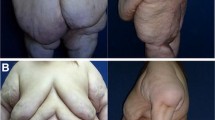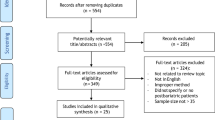Abstract
Background
The advent of bariatric surgery has led to a new subspecialty in plastic surgery for contouring the skin and fat remaining after massive weight loss. This field is increasingly recognized as a vital component to the multi-disciplinary treatment approach to care for the obese patient. The author sought to review key concepts in patient selection, technical advancements, and post-operative care in body contouring following weight loss surgery.
Methods
A literature review in PubMed identified articles relevant to the care of massive weight loss patients presenting for plastic surgical contouring. These articles were combined with a retrospective review of the author’s personal experience in management of these patients.
Results
The best candidates for post-bariatric plastic surgery are those who have achieved weight loss stability with a BMI of 35 or less and who have adequate nutrition to heal the surgical excisions. Truncal deformity is the most common presenting complaint of massive weight loss patients, and the procedure of choice to address this region is a lower body lift. Post-operative care focuses on patient safety prioritizing in DVT prophylaxis and seroma prevention.
Conclusions
Bariatric procedures routinely achieve sustained decreases in body mass index; however, the remaining skin in the massive-weight-loss patient serves as a reminder of their previous obese existence. Post-bariatric body contouring aims to correct this deformity and restore a sense of normalcy. By reshaping the body into its ideal proportions, the true success of the weight loss surgery is fully realized.





Similar content being viewed by others
References
Panel R. 2006. Body contouring after massive weight loss. Plast Reconstr Surg 117(1 Supplement)
Arthurs ZM, Cuadrado D, Sohn V, et al. Post-bariatric panniculectomy: pre-panniculectomy body mass index impacts the complication profile. Am J Surg. 2007;193(5):567–70. discussion 570.
Aly AS, Cram AE, Heddens C. Truncal body contouring surgery in the massive weight loss patient. Clin Plast Surg. 2004;31(4):611–24. vii.
Colwell AS, Borud LJ. Autologous gluteal augmentation after massive weight loss: aesthetic analysis and role of the superior gluteal artery perforator flap. Plast Reconstr Surg. 2007;119(1):345–56.
Hurwitz DJ, Agha-Mohammadi S. Postbariatric surgery breast reshaping: the spiral flap. Ann Plast Surg. 2006;56(5):481–6. discussion 486.
Hurwitz DJ, Holland SW. The L brachioplasty: an innovative approach to correct excess tissue of the upper arm, axilla, and lateral chest. Plast Reconstr Surg. 2006;117(2):403–11. discussion 412-403.
Colwell AS, Borud LJ. Optimization of patient safety in post-bariatric body contouring: a current review. Aesthetic Surg J. 2008;28(4):437–42.
Disclosure
The author declares that she has no conflict of interests.
Author information
Authors and Affiliations
Corresponding author
Rights and permissions
About this article
Cite this article
Colwell, A.S. Current Concepts in Post-bariatric Body Contouring. OBES SURG 20, 1178–1182 (2010). https://doi.org/10.1007/s11695-010-0120-4
Published:
Issue Date:
DOI: https://doi.org/10.1007/s11695-010-0120-4




